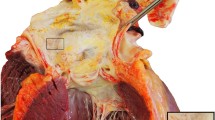Summary
Objective In contrast to granular mediacalcinosis of the aorta, Mönckeberg’s disease is characterized by the occurrence of sheet-like calcification. It is usually said that the pathogenesis of this calcification is unknown. Material and methods To obtain some insight into the mechanism leading to this calcification, we performed light microscopic, scanning electron microscopic and X-ray microanalysis investigations on femoral arteries from autopsies. Results By light microscopy preferentially sheet-like calcifications of different size appeared. In the alizarin redS stain in the neighborhood of these compact structures calcified globules were observed. By SEM in the neighborhood of the compact areas calcified granules were found; the compact structures themselves consisted of granules sticking one onto the other. X-ray microanalysis exhibited high contents of calcium and phosphorus in the compact calcifications; they also showed a minor content of magnesium. Isolated granules inside the compact calcifications showed a nearly identical composition, while granules outside in the surrounding media consisted preferentially from calcium and phosphorus, but they exhibited a slight higher magnesium content. Conclusions It is concluded that Mönckeberg’s media calcification is due to dystrophic calcification. Calcified matrix vesicles from necrotic cells, as it is assumed for the pathogenesis of the calcification of arteriosclerotic plaques (31) , are interpreted as precursors of the solid calcifications which may develop by confluence and sticking one onto the other of calcified globules.
Zusammenfassung
Im Gegensatz zur granulären Mediakalzinose der Aorta ist die Mönckeberg-Krankheit durch das Auftreten schollenartiger Verkalkungen in der Tunica media muskulärer Arterien gekennzeichnet. Eine größere Anzahl der Autoren ist der Meinung, dass die Pathogenese dieser Verkalkung weiterhin unbekannt ist. Um einen Einblick in den Verkalkungsmechanismus zu erhalten, wurden licht- und elektronenmikroskopische sowie röntgenmikroanalytische Untersuchungen an autoptisch gewonnenen Femoralarterien durchgeführt. Lichtmikroskopisch stellten sich in der Media unterschiedlich große Kalksalzherde dar. Die Alizarinrot-S-Färbung zeigte in der Nachbarschaft dieser kompakten Verkalkungen Kalksalzgranula, die kompakten Schollen setzten sich rasterelektronenmikroskopisch aus verkalkten Granula zusammen. Röntgenmikroanalytisch enthielten die Schollen Kalzium und Phosphor und einen geringen Magnesiumanteil. Isolierte Granula in der Nachbarschaft der Schollen zeigten eine etwa gleichartige Verteilung der Elemente mit einem jedoch gering höheren Magnesiumgehalt. Die Untersuchungsbefunde legen nahe, dass die Mönckeberg-Mediaverkalkung auf eine dystrophische Verkalkung zurückzuführen ist. Es wird vermutet, dass verkalkte Matrixvesikel, eventuell untergehenden Zellen entstammend, wie auch für die Pathogenese der verkalkten arteriosklerotischen Plaques angenommen wird (31), die Vorläufer der soliden Verkalkungen darstellen. Durch Konfluenz und Verbackung der Kalzisphäriten entwickeln sich die für die Mönckeberg-Krankheit charakteristischen Kalkschollen.
Similar content being viewed by others
Author information
Authors and Affiliations
Additional information
Eingegangen: 13. November 2001 Akzeptiert: 15. Januar 2002
Rights and permissions
About this article
Cite this article
Mohr, W., Görz, E. Morphogenese der Mediakalzinose des Morbus Mönckeberg Lichtmikroskopische, rasterelektronenmikroskopische und röntgenmikroanalytische Untersuchungsbefunde. Z Kardiol 91, 557–567 (2002). https://doi.org/10.1007/s00392-002-0812-4
Issue Date:
DOI: https://doi.org/10.1007/s00392-002-0812-4




